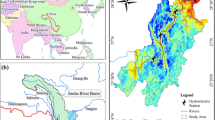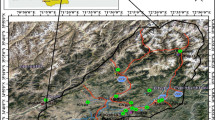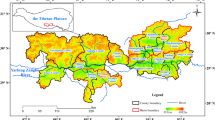Abstract
Mapping and assessing soil-erosion risk can address the likelihood of occurrence of erosion as well as its consequences. This in turn provides precautionary and relevant suggestions to assist in disaster reduction. Because soil erosion by water in the watershed of the Ningxia-Inner Mongolia reach of the Yellow River is closely related to silting of the upper reaches of the Yellow River, it is necessary to assess erosion risk in this watershed. This study aims to identify the soil-erosion risk caused by water in the watershed of the Ningxia-Inner Mongolia reach of the Yellow River from 2001 to 2010. Empirical models called Chinese Soil Loss Equation (CSLE) and Modified Universal Soil Loss Equation (MUSLE) were used to predict the erosion modulus in slope surfaces and gullies. Then the soil erosion risk in this watershed was assessed according to the classification criteria of soil erosion intensities (SL190–2007). The study results showed that the range of values of the erosion modulus in this watershed was 0–44,733 t/km2/a. More than 20% of the total watershed area was found to present an erosion risk, with the regions at risk mainly located in channels and their upper reaches, and in mountainous areas. To determine the regression coefficients of the erosion factors with respect to erosion modulus, a GWR (geographically weighted regression) was carried out using the ArcGIS software. It was found that the topographic factor has the highest contribution rate to the soil erosion modulus, while the highest contribution rate of the erosion factors to the erosion modulus and the largest values of the factors were not located in the same places. Based on this result, the authors propose that slope management is the most important task in preventing soil loss in this watershed, and the soil-conservation projects should be built according to the contribution rate of the erosion factors.
Similar content being viewed by others
Reference
Boardman J, Poesen J (2006) Soil erosion in Europe: major processes, causes and consequences. In: Boardman J, Poesen J, (eds.), Soil Erosion in Europe. Chichester. England: Wiley. DOI: 10.1002/0470859202.ch36.
Cebecauer T, Jaroslav Hofierka J (2008) The consequences of land-cover changes on soil erosion distribution in Slovakia. Geomorphology 98: 187–198. DOI: 10.1016/j.geomorph.2006.12.035
Cheng L, Yang QK, Xie HX, et al. (2009) GIS and CSEL based quantitative assessment of soil erosion in Shaanxi, China. Journal of Soil and Water Conservation 23(5): 61–66.
Dai, YM (2008) Key technology of water and sediment regulation of reservoirs on the main stream of the Yellow River and revised operation mode of Longyangxia Reservoir and Liujiaxia Reservoir. Research Report of Yellow River Institute of Hydraulic Research, Yellow River Conservancy Commission. p 84.
De Jong SM, Paracchini ML, Bertolo F, et al. (1999) Regional assessment of soil erosion using the distributed model SEMMED and remotely sensed data. Catena 37(3–4): 291–308. DOI: 10.1016/S0341-8162(99)00038-7
Fu BJ, Zhao WW, Chen LX, et al. (2006) Evaluation index of soil erosion in different scales. Chinese Science Bulletin 51(16): 1936–1943.
Grimm M, Jones RJA, Rusco E, et al. (2003) Soil erosion risk in Italy: a revised USLE approach. European Soil Bureau Research Report No.11, EUR 20677 EN, p.28. Luxembourg: Office for Official Publications of the European Communities.
Hickey RJ (2000) Slope angle and slope length solutions for GIS. Cartography (Canberra) 39(1): 1–8. DOI: 10.1080/00690805.2000.9714334
Hu LJ, Li R, Yang QK (2001) Region caled water erosion assessment based on GIS. Acta Pedological Sinica 38(2): 167–175.
Jager S (1994) Modelling regional soil erosion susceptibility using the USLE and GIS. In: Rickson (ed.), Conserving Soil resources: European Perspectives. Wallingford: CAB International. pp 161–177.
Jetten V, Govers G, Hessel R (2003) Erosion models: quality of spatial predictions. Hydrological Processes 17: 887–900. DOI: 10.1002/hyp.1168
Jiao JY, Wang WZ, Li J, et al. (2001) Soil and water conservation benefit of warping dams in hilly and gully regions on the Leoss Plateau. Journal of Arid Land Resources and Environment 15(1): 78–83.
Kang LL, Bao H, Liu LB, et al. (2005) Analysis and confirm of the indexes of water storage and sediment trapping on the terrace of different type regions at the Loess Plateau. Science of Soil and Water Conservation 3(2): 51–56.
Kheir RB, Cerdan O, Abdallah C (2006) Regional soil erosion risk mapping in Lebanon. Geomorphology 82: 347–359. DOI: 10.1016/j.geomorph.2006.05.012
Kirkby M, King D (1999) Summary report on provisional RDI erosion risk map for France. Report on contract to the European Soil Bureau (unpublished).
Laflen JM, Moldenhauer WC (2003) Pioneering soil erosion prediction: the USLE story. World Association of Soil & Water Conservation, Special Publ. 1, WASWC, Thailand. p 43.
Li M, Li ZB, Liu PL (2002) Development of quantitative research on soil erosion in China. Research of Soil and Water Conservation 9(3): 243–248.
Li J, Zheng XM (1995) Analysis on erosion reduction mechanism and sediment reduction function of check dam. Bulletin of Soil and Water Conservation 15(2): 33–37.
Liu BY, Zhang KL, Xie Y (2002) An empirical soil loss equation. Proceeding 12th International Soil Conservation Organization Conference, Vol. II: process of soil erosion and its environment effect. Tsinghua University Press, Beijing, China. pp 21–25.
Merritt W, Letcher R, Jakeman A (2003) A review of erosion and sediment transport models. Environmental Modelling & Software 18: 761–799. DOI: 10.1016/S1364-8152(03)00078-1
Ministry of Water Resources of the People’s Republic of China (2007) Classification criterions of soil erosion intensities (SL190–2007). China WaterPower Press, Beijing, China.
Ministry of Water Resources of the People’s Republic of China (1991) The Frist National Remote Sensing Survey of Soil Loss. China WaterPower Press, Beijing, China.
Ministry of Water Resources of the People’s Republic of China (2001) The Second National Remote Sensing Survey of Soil Loss. China WaterPower Press, Beijing, China.
Ministry of Water Resources of the People’s Republic of China (2005) The Third National Remote Sensing Survey of Soil Loss. China WaterPower Press, Beijing, China.
Nekhay O, Arriaza M, Boerboom L (2009) Evaluation of soil erosion risk using Analytic Network Process and GIS: A case study from Spanish mountain olive plantations. Journal of Environmental Management 90: 3091–3104. DOI: 10.1016/j.jenvman.2009.04.022
OECD (2008) Environmental Performance of Agriculture at a Glance OECD Publications, Paris. p. 126. Available online: http://www.oecd.org/dataoecd/61/28/40953155.pdf. (Accessed on 28 June 2008)
Prasuhn V, Liniger H, Gisler S, et al. (2013) A high-resolution soil erosion risk map of Switzerland as strategic policy support system. Land Use Policy 32: 281–291. DOI: 10.1016/j.landusepol.2012.11.006
Poesen JWA, Hooke JM (1997) Erosion, flooding and channel management in Mediterranean environments of southern Europe. Press in Physical Geography 21: 157–199. DOI: 10.1177/030913339702100201
Ran DC, Luo QH, Wang H, et al. (2004) Effect of soil-retaining dams on flood and sediment reduction in middle reaches of Yellow River. Journal of Hydraulic Engineering 5: 7–13.
Renard KG, Foster GR, Yoder DC, et al. (1994) RUSLE revisited: status, question, answers, and the future. Journal of Soil and Water Conversation 49(3): 213–220.
Renard KG, Foster GR, Weesies GA, et al. (1997) Predicting soil erosion by water: a guide to conservation planning with the revised universal soil loss equation (RESUL). US Department of Agriculture, Agriculture Handbook No. 703, Washington, DC, USA.
Van Der Knijff JM, Jones RJA, Montanarella L (1999) Soil erosion risk assessment in Italy. European Soil Bureau.
Van Der Knijff JM, Jones RJA, Montanarella L (2000) Soil erosion risk assessment in Europe. EUR 9044 EN. Luxembourg: Office for Official Publications of the European Communities. p 44.
Van Rompaey AJJ, Bazzoffi P, Jones R (2003) Validation of soil erosion risk assessments in Italy. European Soil Bureau Research. Luxembourg: Office for Official Publications of the European Communities, Report No.12, EUR 20676 EN. p 25.
Williams JR (1995) Chapter 25: the EPIC model. In: Singh VP (ed.), Computer Models of Watershed Hydrology. Water Resource Publication LLC, Englewood, Colorado, USA. pp 909–1000.
Wischmeier WH, Smith DD (1965) Predicting rainfall-erosion losses from cropland east of the Rocky Mountains: guide for selection of practices for soil and water conservation. In: USDA Agricultural Handbook No. 282: ARS, Washington DC, USA. p 47.
Wu Q, Wang MY (2007) A framework for risk assessment on soil erosion by water using an integrated and systematic approach. Journal of Hydrology 337: 11–21.
Xie HX (2008) Study on the Spatio-temporal Change of Soil Loss and on the Assessment of Impact on Environment of Soil and Water Conservation in Yanhe Basin. PHD Thesis, Shaanxi Normal University, Xi’an, China. p 54.
Xu LF, Xu XG, Meng XW (2012) Risk assessment of soil erosion in different rainfall scenarios by RUSLE model coupled with Information Diffusion Model: A case study of Bohai Rim, China. Catena 100: 74–82.
Yang Y (1990) Prediction formula for regional soil erosion. Soil Transaction 27(1): 73–78.
Yoder D, Lown J (1995) The Future of RUSLE: inside the new revised universal soil loss equation. Journal of Soil and Water Conservation 50(5): 484–489.
Zhu D, Wang TW, Cai CF (2010) Rapid assessment of regional soil erosion based on fuxxy neural system and GIS. Transactions of the Chinese Society of Agricultural Engineering 26(1): 103–107.
Zhu Y, Zhang WB, Liu SH, et al. (2012) A batch computation method of soil erosion modulus in the Frist National Water Conservancy Survey-Design and application of water erosion modulus calculator based on CSLE and GIS. Bulletin of Soil and Water Conservation 32(5): 291–295.
Author information
Authors and Affiliations
Corresponding author
Additional information
0000-002-3300-2921
0000-0003-1795-8656
0000-0003-1679-3968
Rights and permissions
About this article
Cite this article
Du, Hq., Xue, X. & Wang, T. Mapping the risk of water erosion in the watershed of the Ningxia-Inner Mongolia reach of the Yellow River, China. J. Mt. Sci. 12, 70–84 (2015). https://doi.org/10.1007/s11629-013-2861-8
Received:
Accepted:
Published:
Issue Date:
DOI: https://doi.org/10.1007/s11629-013-2861-8




